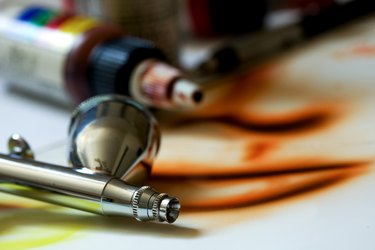
If you think the suntans on the thousands of extras in the film Ben-Hur were a condition of employment, think again. The makeup studio discovered that airbrushing the actors to look like Romans got the job done more efficiently, and the tans looked more realistic than by applying the darkening lotion by hand. From makeup and manicure artists to custom cars, clothing, suntan booths and even bakeries, the airbrush has become a staple for many artists. It's easy to airbrush acrylic paint as long as you get the right consistency and use it in a very clean airbrush.
History of Acrylic Paint
Video of the Day
Acrylic paints are made of three components: pigment that gives the paint its color, water that holds it together and the binder that holds the paint to the surface when the water evaporates. Acrylics came into use as an artist's medium as Depression-era muralists experimented with the synthetic paint, with noted artists such as Jackson Pollock, Lichtenstein and Rothko adopting the vibrantly colored medium for its fluidity and quick-drying ability. By 1955, commercially produced, water-based acrylic paints were readily available and became the go-to medium for contemporary artists.
Video of the Day
Types of Airbrush Acrylic Paint
Acrylic paints work well in an airbrush because they are water-based, and mistakes can be immediately corrected. They also dry quickly, have no fumes and are easy to clean from the airbrush. Specialty stores sell airbrush acrylic paint that is ready to use, but if your specific color isn't available, you can mix your own homemade acrylic paint from commercial acrylics. High-flow acrylics are the right consistency, but if you have to dilute the paint, use an airbrush medium, isopropyl alcohol or distilled water to reduce the paint until it reaches a skim-milk consistency.
Finding the Right Consistency
It's a matter of "try and try again" when finding the right consistency of acrylic paint for your airbrush. Consider the type of airbrush you're using, its needle, the air pressure and the nozzle size when you're mixing your acrylic paint. The larger the nozzle, the thicker the paint flows, so experiment to discover which combination works for your project. Airbrush thinner is a commercial product that you can buy, but be aware that paint extenders make the paint more transparent.
Thin Acrylics With Caution
Too much water (more than 25 percent) renders the acrylic paint unstable. The pigment molecules won't attach themselves to one another, and the paint won't attach itself to the selected surface. Use an acrylic medium, which is paint without the color, to thin acrylic paint and then experiment with the airbrush to get the right air pressure poundage.
How an Airbrush Works
An airbrush needs two components to work: air and paint. Unlike an aerosol can that automatically sprays with the push of a button, an airbrush needs an external source of pressurized air fed by a compressor or air tank. The different types of airbrushes work on gravity, feeding paint via a siphon, and airbrushes work with a side-feeding container. Play with all types to determine which works best for you.
Cleaning your airbrush is probably the most important task after using it. Be sure that the nozzle is spotless, and the body of the airbrush should be cleaned to its original shine. Most problems with airbrushes are due to paint clogging the inside. Paint thinner is the first go-to for cleaning followed by flushing with water. Commercial cleaners are also available, as are more complex solutions.